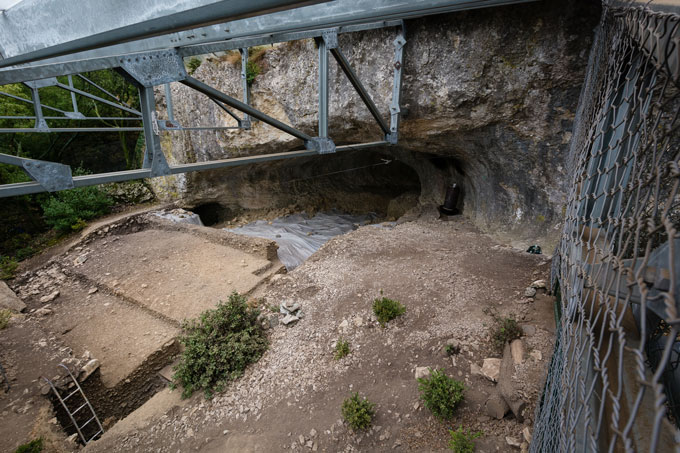Neandertals traveled at least two evolutionary paths on their way to extinction around 40,000 years ago, a new study suggests.
Whether classified as a separate species or a variant of Homo sapiens, Neandertals have typically been viewed as a genetically consistent population. But an adult male’s partial skeleton discovered in France contains genetic clues to a Neandertal line that evolved apart from other European Neandertals for around 50,000 years, nearly up to the time these close relatives of H. sapiens died out, researchers say.
The possibility of a long-lasting, isolated Neandertal population in southwestern Europe supports the idea that these hominids “very likely had their own, complex evolutionary history, with local extinctions and migrations, just like us,” says paleogeneticist Carles Lalueza-Fox of the Institute of Evolutionary Biology in Barcelona, who did not participate in the new study.
A team led by archaeologist Ludovic Slimak of Université Toulouse III – Paul Sabatier in France and population geneticist Martin Sikora of the University of Copenhagen nicknamed the French Neandertal discovery Thorin, after a character in J.R.R. Tolkien’s book The Hobbit. Thorin’s remains, discovered at the entrance of Grotte Mandrin rock shelter in 2015, are still being excavated.
Several dating methods applied to teeth from Thorin and animals buried near his body, as well as Thorin’s position in Grotte Mandrin sediment, indicate that this Neandertal lived between around 50,000 and 42,000 years ago, Slimak’s and Sikora’s group reports September 11 in Cell Genomics.
Molecular segments representing about 65 percent of Thorin’s genome were recovered from a molar, Sikora says. Thorin’s DNA was then compared with DNA previously extracted from other Neandertals, ancient H. sapiens and present-day people.
Arrays of gene variants in Thorin’s DNA more closely align with the previously reported DNA structure of Neandertals that lived around 105,000 years ago, versus Neandertals dating to around 50,000 to 40,000 years ago. Yet analyses of carbon and other diet-related chemical elements in Thorin’s bones and teeth suggest that he lived during an ice age, which did not develop in Europe until about 50,000 years ago.

H. sapiens and Neandertals may have alternated occupations of Grotte Mandrin a few times between about 56,800 and 40,000 years ago (SN: 2/9/22). Thorin’s DNA shows no signs of having acquired genes via mating either with Neandertals outside his lineage or with H. sapiens.
Thorin also inherited from his parents an unusually high percentage of DNA segments containing consecutive pairs of identical gene variants. Reduced genetic variation of that kind, previously found in Siberian Neandertals, reflects mating among close relatives in a small population (SN: 10/19/22).
Taken together, the genetic evidence fits a scenario in which Thorin belonged to a Neandertal lineage that split from other European Neandertals around 105,000 years ago, the researchers say. For roughly the next 50,000 years, they suspect, Thorin’s lineage consisted of small networks of closely related communities that exchanged mates.
Reasons why those ancient groups avoided mating with other Neandertals in the region, possibly related to language or cultural differences, are unclear, Sikora says.
It is hard to say whether the population size of Thorin’s lineage stayed constant or declined over time, perhaps as communities became more isolated, Sikora says. Thorin currently represents the only source of DNA from his lineage.
Similarities of Thorin’s DNA to that of a Neandertal individual from Gibraltar, on Spain’s southern tip, suggest that the newly reported lineage extended across parts of southwestern Europe, the investigators say. No consensus exists on an age for the Gibraltar fossil, a partial braincase found at a quarry in 1848.
“If Thorin is really 50,000 years old, this would be an amazing finding showing a strong genetic structure in late Neandertals,” says paleogeneticist Cosimo Posth of the University of Tübingen in Germany. But, he says, further excavation and research at Grotte Mandrin will need to confirm when Thorin lived.
Researchers found Thorin’s remains in a small, natural depression on the rock shelter floor. Slimak’s and Sikora’s group cannot yet say how the body got there or whether it originated in older sediment. An older date for the partial skeleton would indicate, less surprisingly, that Thorin belonged to an isolated population that petered out quickly.
Long-term isolation would have resulted in Thorin inheriting a greater number of short DNA segments containing identical gene pairs than reported in the new study, Lalueza-Fox says. Isolating more of Thorin’s DNA or collecting genetic remnants from other fossil members of his lineage will clarify the evolutionary story of these close-knit Neandertals, he says.
#Ancient #DNA #unveils #previously #unknown #line #Neandertals
Image Source : www.sciencenews.org